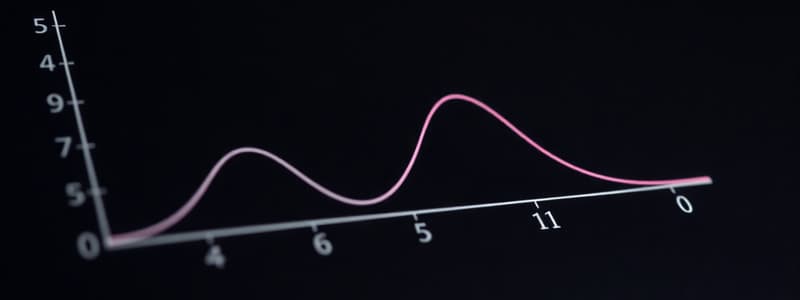Podcast
Questions and Answers
What is a significant advantage of a family business?
What is a significant advantage of a family business?
- Lower operational costs
- High employee turnover
- Trust and togetherness among members (correct)
- Increased access to venture capital
What is a potential disadvantage of a family business?
What is a potential disadvantage of a family business?
- Owners can always get away from the business
- Employees are always happy to work for family
- There is increased access to funding
- Owners have difficulty viewing the venture objectively (correct)
What can help minimize conflict in a family business?
What can help minimize conflict in a family business?
- Making decisions based on personal emotions
- Avoiding clear lines of responsibility
- Establishing clear lines of responsibility (correct)
- Ignoring individual family members' needs
What percentage of businesses in the United States are family owned and managed?
What percentage of businesses in the United States are family owned and managed?
What is typically already in place when buying an existing business?
What is typically already in place when buying an existing business?
Flashcards
Greatest advantage of a family business?
Greatest advantage of a family business?
Trust and togetherness among family members.
Greatest disadvantage of a family business?
Greatest disadvantage of a family business?
Owners can never get away from the business, hard to be objective.
Why buy an existing business?
Why buy an existing business?
Less risky than starting from scratch because employees are trained/hired, or equipment is in place.
Goodwill
Goodwill
Signup and view all the flashcards
How many businesses are family owned?
How many businesses are family owned?
Signup and view all the flashcards
Study Notes
- Provides an overview of statistical distributions
- Details both discrete and continuous distributions
Probability Distributions
- Tables presented for discrete and continuous distributions, outlining key properties
Discrete Distributions
- Bernoulli distribution models the probability of success or failure of a single trial
- pmf: probability mass function is $p^x(1-p)^{1-x}$
- Mean: $p$
- Variance: $p(1-p)$
- Support: $x \in {0, 1}$
- Binomial distribution counts the number of successes in a fixed number of independent Bernoulli trials
- pmf: ${n \choose x}p^x(1-p)^{n-x}$
- Mean: $np$
- Variance: $np(1-p)$
- Support: $x \in {0, 1, 2,..., n}$
- Geometric distribution models the number of trials needed to get the first success in a series of Bernoulli trials
- pmf: $p(1-p)^{x-1}$
- Mean: $\frac{1}{p}$
- Variance: $\frac{1-p}{p^2}$
- Support: $x \in {1, 2, 3,...}$
- Negative Binomial distribution models the number of trials needed to achieve a fixed number of successes
- pmf: ${x-1 \choose r-1}p^r(1-p)^{x-r}$
- Mean: $\frac{r}{p}$
- Variance: $\frac{r(1-p)}{p^2}$
- Support: $x \in {r, r+1, r+2,...}$
- Hypergeometric distribution models the probability of successes in a sample without replacement
- pmf: $\frac{{K \choose x}{N-K \choose n-x}}{{N \choose n}}$
- Mean: $\frac{nK}{N}$
- Variance: $n\frac{K}{N}\frac{N-K}{N}\frac{N-n}{N-1}$
- Support: $max(0, n-(N-K)) \le x \le min(n, K)$
- Poisson distribution models the number of events occurring in a fixed interval of time or space
- pmf: $\frac{\lambda^xe^{-\lambda}}{x!}$
- Mean: $\lambda$
- Variance: $\lambda$
- Support: $x \in {0, 1, 2,...}$
- Discrete Uniform distribution assigns equal probability to each outcome in a finite set
- pmf: $\frac{1}{b-a+1}$
- Mean: $\frac{a+b}{2}$
- Variance: $\frac{(b-a+1)^2 - 1}{12}$
- Support: $x \in {a, a+1, a+2,..., b}$
Continuous Distributions
- Uniform distribution assigns constant probability density over an interval
- pdf: $\frac{1}{b-a}$
- Mean: $\frac{a+b}{2}$
- Variance: $\frac{(b-a)^2}{12}$
- Support: $x \in [a, b]$
- Exponential distribution models the time until an event occurs in a Poisson process
- pdf: $\lambda e^{-\lambda x}$
- Mean: $\frac{1}{\lambda}$
- Variance: $\frac{1}{\lambda^2}$
- Support: $x \in [0, \infty)$
- Gamma distribution generalizes the exponential distribution and models the time until multiple events occur in a Poisson process
- pdf: $\frac{\beta^\alpha}{\Gamma(\alpha)}x^{\alpha-1}e^{-\beta x}$
- Mean: $\frac{\alpha}{\beta}$
- Variance: $\frac{\alpha}{\beta^2}$
- Support: $x \in [0, \infty)$
- Chi-squared distribution is the distribution of a sum of squared standard normal variables
- pdf: $\frac{1}{2^{k/2}\Gamma(k/2)}x^{k/2 - 1}e^{-x/2}$
- Mean: $k$
- Variance: $2k$
- Support: $x \in [0, \infty)$
- Normal distribution is a bell-shaped distribution often used to model real-valued random variables with unknown distributions
- pdf: $\frac{1}{\sigma\sqrt{2\pi}}e^{-\frac{1}{2}(\frac{x-\mu}{\sigma})^2}$
- Mean: $\mu$
- Variance: $\sigma^2$
- Support: $x \in (-\infty, \infty)$
- Bivariate Normal distribution extends the normal distribution to model two correlated variables
- Means: $\mu_x, \mu_y$
- Variances: $\sigma_x^2, \sigma_y^2$
- Support: $x, y \in (-\infty, \infty)$
Notes
- pmf refers to the probability mass function
- pdf refers to the probability density function
Studying That Suits You
Use AI to generate personalized quizzes and flashcards to suit your learning preferences.




